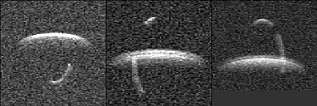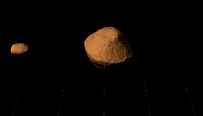(66391) 1999 KW4
 Radar images of 1999 KW4 taken at Goldstone | |
| Discovery [1] | |
|---|---|
| Discovered by | LINEAR |
| Discovery site | Lincoln Lab's ETS |
| Discovery date | 20 May 1999 |
| Designations | |
| 1999 KW4 | |
|
Aten · NEO · PHA [1][2] Mercury-crosser Venus-crosser | |
| Orbital characteristics [1] | |
| Epoch 4 September 2017 (JD 2458000.5) | |
| Uncertainty parameter 0 | |
| Observation arc | 19.01 yr (6,942 days) |
| Aphelion | 1.0845 AU |
| Perihelion | 0.2000 AU |
| 0.6422 AU | |
| Eccentricity | 0.6886 |
| 0.51 yr (188 days) | |
| 359.03° | |
| 1° 54m 54s / day | |
| Inclination | 38.884° |
| 244.91° | |
| 192.62° | |
| Earth MOID | 0.0138 AU · 5.4 LD |
| Physical characteristics | |
| Dimensions |
1.3 km (taken)[3] 1.317±0.040 km[1] (1.5 x 1.5 x 1.34) km[1] |
|
2.7650 h[4] 9.581±0.019 h[5] | |
| 0.26 (derived)[3] | |
| SMASS = S:[1] · S [3] | |
| 16.5[1][3] | |
|
| |
(66391) 1999 KW4, provisional designation 1999 KW4, is a binary[6] asteroid, classified as near-Earth object and potentially hazardous asteroid of the Aten group, approximately 1.3 kilometers in diameter. It was discovered on 20 May 1999, by Lincoln Near-Earth Asteroid Research (LINEAR) at the Lincoln Laboratory's Experimental Test Site in Socorro, New Mexico, United States.[2] It is also a Mercury-crosser and the closest known binary system to the Sun with a perihelion of just 0.2 AU.
Orbit
The asteroid orbits the Sun at a distance of 0.2–1.1 AU once every 6.18 months (188 days). Its orbit has an eccentricity of 0.69 and an inclination of 39° with respect to the ecliptic.[1] A first precovery was taken by 2MASS at the Fred Lawrence Whipple Observatory in 1998, extending the body's observation arc by one years prior to its official discovery observation at Socorro.[2]
As a potentially hazardous asteroid, it has an Earth minimum orbital intersection distance of 0.0138 AU (2,060,000 km) which corresponds to 5.4 lunar distances.[1] On 25 May 2036, it will pass 0.0155 AU (2,320,000 km) from Earth.[7]
Physical characteristics
In the SMASS classification, the asteroid a characterized as a S:-type, which fall into the broader type of stony S-type asteroids.[1]
Satellite

1999 KW4 has a minor-planet moon orbiting it. The moon, designated S/2001 (66391) 1 is approximately 360 metres in diameter, and orbits its primary in every 16 hours at a mean-distance of 2.6 kilometers. The presence of a companion was suggested by photometric observations made by Pravec and Šarounová and was confirmed by radar observations from Arecibo observations and announced on 23 May 2001 (also see below).[4][6]
Diameter and shape
According to radiometric observations from Arecibo Observatory, the asteroid has a mean diameter of 1.317 kilometers. The observations were taken from May 21–23, 2001, by Lance A. M. Benner, Steven J. Ostro, Jon D. Giorgini, Raymond F. Jurgens, Jean-Luc Margot and Michael C. Nolan.[8]
The Collaborative Asteroid Lightcurve Link adopts a diameter of 1.3 kilometers and derives an albedo 0.26 with an absolute magnitude of 16.5.[3]
The shapes of the two bodies and their dynamics are complex.[9] With a dimension of 1.5 x 1.5 x 1.34 kilometers for a simple triaxial ellipsoid, the asteroid has an oblate shape, which is dominated by an equatorial ridge at the body's potential-energy minimum. This bizarre property of the equatorial region is close to breakup: raising a particle a meter above the surface would put it into orbit. As seen in the image at above right, the gravitational effects between the moon and the asteroid create a gigantic mountain extending in the equatorial plane around the entire asteroid.
Lightcurves
During 19–27 June 2000, a rotational lightcurve of this asteroid was obtained from photometric observations by Petr Pravec and Lenka Šarounová at Ondřejov Observatory. Lightcurve analysis gave a rotation period of 2.7650 hours with a brightness variation of 0.12 magnitude (U=3).[4]
In September 2016, the most recent and poorly rated rotational lightcurve with a period of 9.581±0.019 hours was obtained by the Spanish amateur astronomer group OBAS (U=1).[5]
Numbering and naming
This minor planet was numbered by the Minor Planet Center on 10 September 2003.[10] As of 2018, it has not been named.[2]
References
- 1 2 3 4 5 6 7 8 9 10 "JPL Small-Body Database Browser: 66391 (1999 KW4)" (2017-05-31 last obs.). Jet Propulsion Laboratory. Retrieved 1 June 2017.
- 1 2 3 4 "66391 (1999 KW4)". Minor Planet Center. Retrieved 30 March 2017.
- 1 2 3 4 5 "LCDB Data for (66391)". Asteroid Lightcurve Database (LCDB). Retrieved 1 June 2017.
- 1 2 3 Pravec, P.; Scheirich, P.; Kusnirák, P.; Sarounová, L.; Mottola, S.; Hahn, G.; et al. (March 2006). "Photometric survey of binary near-Earth asteroids". Icarus. 181 (1): 63–93. Bibcode:2006Icar..181...63P. doi:10.1016/j.icarus.2005.10.014. Retrieved 1 June 2017.
- 1 2 Lozano, Juan; Flores, Angel; Mas, Vicente; Fornas, Gonzalo; Rodrigo, Onofre; Brines, Pedro; et al. (April 2017). "Seven Near-Earth Asteroids at Asteroids Observers (OBAS) - MPPD: 2016 June-November". The Minor Planet Bulletin. 44 (2): 108–111. Bibcode:2017MPBu...44..108L. ISSN 1052-8091. Retrieved 1 June 2017.
- 1 2 Johnston, Robert (20 September 2014). "(66391) 1999 KW4". Johnston's Archive. Retrieved 30 March 2017.
- ↑ "JPL Close-Approach Data: 66391 (1999 KW4)" (2013-05-09 last obs (arc=14.9 yr)). Retrieved 6 April 2016.
- ↑ Ostro, Steven. J.; Margot, Jean-Luc; Benner, Lance A. M.; Giorgini, Jon D.; Scheeres, Daniel J.; Fahnestock, Eugene G.; et al. (November 2006). "Radar Imaging of Binary Near-Earth Asteroid (66391) 1999 KW4". Science. 314 (5803): 1276–1280. Bibcode:2006Sci...314.1276O. doi:10.1126/science.1133622. Retrieved 1 June 2017.
- ↑ NASA Jet Propulsion Laboratory Asteroid Radar Research, retrieved May 3, 2007
- ↑ "MPC/MPO/MPS Archive". Minor Planet Center. Retrieved 24 February 2018.
External links
| Wikimedia Commons has media related to (66391) 1999 KW4. |
- Margot, Jean-Luc, Radar observations of 1999 KW4 November 1999, retrieved July 2016
- Asteroids with Satellites, Robert Johnston, johnstonsarchive.net
- 1999 KW4 orbit and observations at IAU Minor Planet Center
- (66391) 1999 KW4 at the JPL Small-Body Database